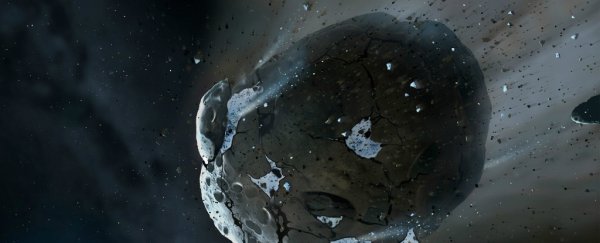The era of dinosaurs ended some 66 million years ago, possibly when a gigantic asteroid broke through Earth's atmosphere, slammed to the ground, and kicked up enough dust to block out the sunlight, killing off plant life and devastating the food chain in the process.
While the exact degree to which this event actually impacted the dinosaurs is up for debate, there's no questioning the giant hole it left behind.
This cataclysmic impact, which released the same amount of energy as 100 million nuclear bombs, is thought to have wiped out many species on Earth, but how did life recover after it, and go on to evolve into the species we know and love today?
That's the question researchers hope to answer by digging inside the Chicxulub Impact Crater in the Gulf of Mexico, the site where the dinosaur-killing asteroid landed millions of years ago. Even crazier, at 180 km in diameter and 30 km deep, the crater is nearly 3.5 times deeper than Mount Everest is tall.
To pull it off, researchers from Curtin University will use a large drilling platform in the Gulf of Mexico to reach the underwater crater, which straddles the Yucatan peninsula. Once there, the team will take a series of sediment and rock samples to hopefully analyse the DNA left behind by ancient animals.
While this sounds rather simple, researchers have been struggling to understand how animals survived the massive impact for years, largely due to the fact that the impact sent a layer of rock and dust - called ejecta - over much of the planet. This formed an 'ejecta layer' that can be found all over the world, says Marco Coolen from Curtin University in Australia.
"No fossil remains of dinosaurs have been found above this ejecta layer, however, avian dinosaurs - that evolved into modern birds - survived the extinction," says Coolen.
The team hopes that by digging into the crater, they'll find information about species such as plankton that are too tiny to leave behind fossils, and can only be identified via DNA fragments and lipid biomarkers.
Besides analysing DNA samples to see which creatures lived there before the impact, the team might also find 'diamondoids' - diamond-shaped molecules that form under very high temperatures. If these are present in the crater, they could help the team understand more about how water heats up in Earth's crust, reports Teresa Belcher for ScienceNetwork.
Needless to say, there's a lot to discover inside the Chicxulub Impact Crater. Hopefully, as the dig gets underway, we'll have a new understanding of how life on Earth rebounded after one of the most catastrophic events to ever happen on our planet.
